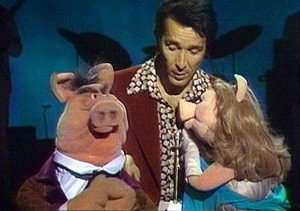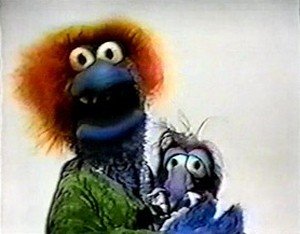Ray the Raychem Seal and Miss Piggy
Today I looked at two unrelated yet fascinating curiosities, the first of which is the first thing I’ve watched for the site that actually wasn’t created or run by Jim Henson at all but which is significant due to its performer, and the second of which features the debut of one of the most important characters in the entire Muppet canon.
We begin a short industrial video, much like the films Jim made for companies such as IBM, but this one was actually done by Dave Goelz, who is best known today for performing such beloved characters as Gonzo and Boober Fraggle. In my post on Jim’s 1974 appearance on The Tonight Show with Johnny Carson, I discussed how Goelz originally became involved with the Henson Co., and how Jim initially hired him as a part-time puppet builder. During that same time, however, he continued to do work for other companies, such as this film, in which he plays Ray the Raychem Seal. And while, again, this isn’t work he did for Henson, it’s interesting for a Muppet fan to see Goelz performing another puppet he designed himself.
As I explained earlier, Goelz was initially more comfortable behind-the-scenes as a puppet builder than as a performer (a trait he had in common with other Muppet puppeteers at the beginning, including Jim and Frank Oz), but Jim gave him practice in the latter on The Muppets Valentine Show through the character of Brewster, and here we see him stretching himself in this direction even further. Ray may not have the complexity of the Muppets’ best characters but he is an excellent performance nonetheless: with a bright, funny, sunny personality, and physical movements that broadly call to mind those of an actual seal with a cartoonish overlay that defines the Muppets’ best anthopomorphized animals.
The voice Goelz puts on is also highly reminiscent of the characters in Jim’s gruffer register, like Dr. Teeth and Rowlf. Ray’s punnish name may be a bit on-the-nose–the Raychem company makes sealant for cables, and so this spot makes the “Raychem seal” into a literal seal, a metaphor that gets a bit too stretched by his assertion that “water is a Raychem seal’s natural enemy,” since that makes no sense in context of the animal–but it’s a cute pun, and perhaps most interestingly, his physical design looks a great deal like a Muppet, from the fabric right down to the wide, slightly crossed eyes, which shows just how pervasive Jim Henson’s influence on puppetry was. The film also shows the Henson influence in its slightly subversive streak, such as when Ray is showing off slides of various Raychem cables and realizes that photos of him at the office Christmas party last year, hanging with a busty woman, have accidentally gotten shuffled together with them–which call to mind the “wild office parties” depicted in Jim’s Wilson’s Meats films.
Despite these similarities, however, you can tell this wasn’t produced by Henson because, despite some amusing bits, it isn’t nearly as genuinely funny or clever as it could be–I doubt Jim wouldn’t have noticed the issue with that “water as natural enemy” moment–and doesn’t take enough advantage of the fun concept. Furthermore, the lyrics to the “Raychem jingle” are almost cringe-inducingly weak. Still, it’s definitely worth watching to take a glimpse at early work by an iconic Muppet performer. And you can do so here!
If the first clip is merely interesting, the next batch feature one of the most momentous occurences in the entire run of Henson footage so far, albeit one that they never would have realized the significance of at the time: namely, the screen debut of one Miss Piggy. This earth-shattering event actually appeared as but a brief, practically throwaway gag on a special filmed for British TV (yet another fascinating connection between the Muppets and England, where The Muppet Show was filmed) but is now the equivalent of any before-they-were-stars clip of a superstar captured before their rise to global dominance. And much like most other early, often grainy footage of celebrities earlier in their lives, Miss Piggy is very different in her first appearance than the polished diva she would become.
It happened on Herb Alpert and the Tijuana Brass, a special featuring the eponymous musician and his band performing some of his most famous numbers, produced by ATV, Lord Lew Grade’s company which produced Julie on Sesame Street and would later produce The Muppet Show, and which aired on October 13, 1974. While I wasn’t able to find the entire thing, I was able to track down some highlights on YouTube. The first is the most significant, being that Piggy debut, and a few things jumped out at me immediately.
Those who have seen the first season of The Muppet Show might remember that, when she first started on the show, Piggy had a markedly divergent look to her later years. In some ways, it was the same basic idea of a female pig with more delicate features associated with a human’s idea of glamour, however at the same time she looked more overall piggish, which basically highlighted the absurdity of a pig thinking of herself as a gorgeous example of womanhood. Later on, Piggy’s features would be softened to the point that she looked less like a “real” pig with make-up and more like the beautiful, idealized, glamorous star of stage and screen she had always aspired to be. Well, if Season 1 Piggy looks a bit primitive today, the Piggy that debuts on Herb Alpert looks practically Cro-Magnon by comparison.
People who remember Season 1 well might also recall that, in that first season, Piggy wasn’t actually always performed by Frank Oz, but the role was instead actually split between Richard Hunt and him, meaning that depending on the sketch, her voice could be vastly different, sometimes even within the same episode itself. That is how relatively unimportant a character Piggy was considered at the beginning. Even vocal continuity wasn’t a concern. Well, just as with her looks, if Richard’s rendition of Piggy’s voice was recognizably different than Frank’s yet still in the same broad range, Jerry Nelson’s in this debut is in another category all together. It’s a little odd hearing Richard Hunt’s Piggy voice today but Jerry’s sounds downright bizarre, sounding less like a diva and more like…well…a baby Fraggle.
Also, not only is she not yet a star at this point, but she’s actually a chorus girl who a hoggish talent agent, Hoggy Marsh (performed by Jim in his gruff voice), is trying to convince Herb to hire. And while later Miss Piggy would never put up with the sexism on display in this sketch, she doesn’t seem to have an issue with Hoggy trying to sell her as a “girl singer,” painting a picture of her as “small-time girl trying to make it in the big city,” claiming to have found this innocent gem “in a bus terminal,” wearing a “pink bonnet and polka dot dress” and holding a “cardboard suitcase with a string around it,” and Herb scoffing in response that he doesn’t need a “girl singer”. At the same time, being a shy, young chorus girl with no success or experience yet here, she doesn’t really have the power yet to object to their words. And it’s also quite fascinating to see her at an earlier point in her career, younger and more innocent.
And while she may not yet have the strength, ego, and gumption of our Piggy, she already has the flirtateousness down pat. The instant she sees Herb, she practically melts, spending almost the entire time gazing up into his eyes and nuzzling him, in a preview of the treatment Kermit would be receiving for many years to come! Unfortunately, she also however doesn’t yet have much talent yet, either, desperately attempting to warble through “I Can’t Give You Anything But Love” and sounding fairly terrible in the process.
And, again, as with her looks, it’s an interesting depiction of just how much her character shifted over the years. At the beginning, the fact that she was a pig who wanted to be a Hollywood star was the joke but as she evolved and became a legitimate star in her own right–not just in the world of the show but in the real world, as well–it got to the point where we no longer have trouble accepting her as being a diva. That level of absurdity has melted away by this point and we have no trouble suspending our disbelief, possibly because she believes so strongly and forcefully in her own beauty and talent that we can’t help but believe it, as well.
Early on, jokes were made at Piggy’s expense re: her not being as gorgeous and musically gifted as she herself claimed. Years later, however, by the time Kermit was struck with amnesia in The Muppets Take Manhattan and laughed at the idea of Piggy and him as a romantic item, it was a sign that something was very wrong with him at the moment. Because, again, by that point, she had become who she had always wanted to be, and we happily accepted it, because Piggy would accept nothing less. But for a study in extreme contrast, you can watch her in this debut right here.
Other clips of the show I was able to find include an appearance by multiple Snerfs (trumpet-nosed, fluffy Muppet creatures with necks that expand and shrink) dancing in a chorus line to “In a Little Spanish Town,” which you can watch here, and a rendition of the song “Five Minutes More,” featuring a female version of Beautiful Day chasing a silent Gonzo around the stage, which you can watch here. As in his Great Santa Claus Switch appearance, Gonzo isn’t yet performed by Goelz, nor does he have his name or current identity, though he looks like the sad-eyed Gonzo of the first season of The Muppet Show, who was more of a pathetic, Eeyore-like figure than the zany, bursting-with-life, always-game-for-adventure character he would become.
And next week, come back for my recap of Sesame Street‘s sixth season premiere, which just so happens to be episode #666!



